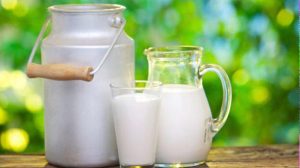Researchers have concluded that regular consumption of low-fat and nonfat dairy products is associated with increased risk for Parkinson’s disease (PD). (2)
For the current analysis, the researchers used data collected since 1984 for the NHS and 1986 for the HPFS. A questionnaire of particular interest was the food frequency questionnaire, where participants detailed how frequently over the past year they consumed a commonly used portion of different foods. They were then grouped into categories according to their intake of dairy foods.
The analysis included about 80,000 women in the NHS and about 48,000 men in HPFS who completed the food frequency questionnaires.
Over about 25 years of follow-up, the researchers documented more than 1000 cases of PD that were first self-reported and later confirmed by medical record review. They were then able to use these data to estimate the risk for PD according to how much dairy participants consumed.
Total dairy intake was not significantly associated with PD risk. However, intake of low-fat dairy foods was associated with an increased risk for the disease.
After adjustment for smoking, physical activity, coffee intake, body mass index, alcohol intake, and total caloric intake, the hazard ratio (HR) comparing people who consumed at least 3 servings of low-fat dairy per day with those who consumed none was 1.34 (95% confidence interval [CI], 1.01 – 1.79; P trend = .04).
This association appeared to be driven by an increased risk for PD associated with consumption of skim and low-fat milk (HR, 1.39; 95% CI, 1.12 – 1.73; P trend < .01). (3)
Kathleen Shannon, MD, Detling Professor and chair, Department of Neurology, University of Wisconsin School of Medicine and Public Health, Madison, spokesperson for the American Academy for Neurology when asked for comment replied: “I think the study is very interesting but it is unclear how important it is. It’s a fairly modest effect. It’s not like doubling the risk — it’s a 30% increase in risk. Also, it is never clear with epidemiology why some people are drinking more low-fat products. Is there a weight problem?”
Dr. Shannon goes on to say, “I don’t think the results should be taken to change the way people approach their diet.” (3)
We strongly disagree. Wisdom teaches that the body is made of and built by food, and disease in the body is directly related to how and what it is fed.
The Ayurvedic Perspective on Milk: Annamaya Kosha, the body made of food
Ayurveda considers the health of the whole body and its balance or equilibrium within the larger ecosystem and the environment. The agricultural husbandry and care of dairy cows, along with the use of cow’s milk and its malas (wastes) have been described at length in the Vedic texts and the medical texts of Ayurveda. Ayurvedic acharyas have long recommended cow’s milk for very specific purposes:
- It is sweet, heavy, unctuous and cold (which alleviates vata and pitta during the summer months)
- It is a rejuvenator, life-giving, promotes strength and the intellect, and nourishes and builds the seven layers of tissues in the body (the sixth of seven tissue layers is majja dhatu which includes the nervous system)
- It is beneficial for children, the emaciated, and the elderly due to its building and nourishing properties
- It is one of a few substances on earth claimed by the Ayurvedic sages to directly nourish and restore Ojas (a subtle energy which resides in the heart and circulates throughout the body)
- It is helpful to promote and build reproductive fluids.
In general, enjoy non-homogenized whole fat dairy milk steamed or heated and well spiced, as the medical texts of Ayurveda have advised for millennia (which will eliminate food borne pathogens such as E. Coli and Salmonella). (3)
As one client recently commented: “It is so refreshing to work with a practitioner who is not afraid to recommend milk.” As Ayurvedic practitioners, we know that the appropriate use of any substance can become like elixir to the body and may be used as medicine, but with inappropriate and unseasonable use, the same substance can be toxic to the body.
Book your appointment today to discover the healthful purpose and uses of full fat dairy and other high fat foods for nourishing and improving the function of majja dhatu – the tissue layer of the body including the nervous system.
References
Baines H. The Benefits of Cow’s Milk, an Ayurvedic Perspective. Healthy Ayurveda. 2015 Aug 11. Available online http://healthyayurveda.com/generally-wholesome-to-living-b…/
Hughes KC, et al. Intake of dairy foods and risk of Parkinson disease. Neurology. 2017 Jun 8. pii: 10.1212/WNL.0000000000004057. doi: 10.1212/WNL.0000000000004057. [Epub ahead of print]
Lowry F. Low-Fat Dairy Linked to Increased Parkinson’s Risk. Medscape. 2017 Jun 9. Available online http://www.medscape.com/viewarticle/881349?

